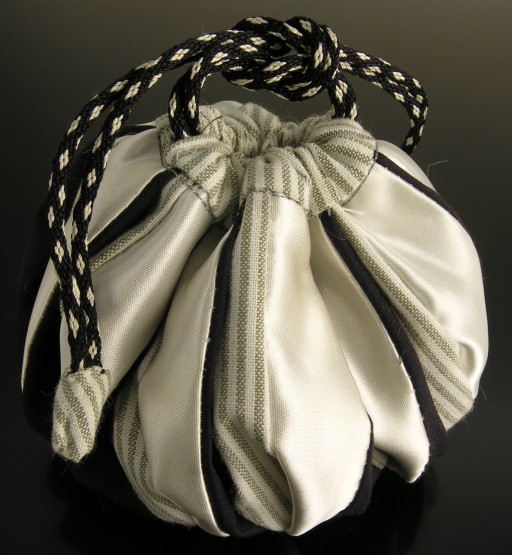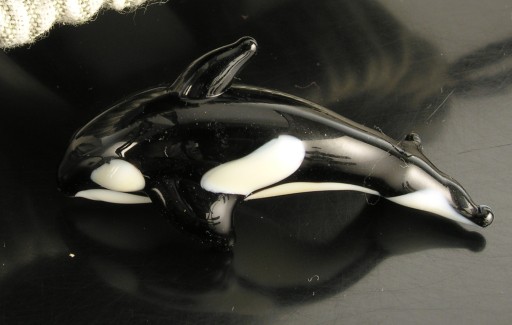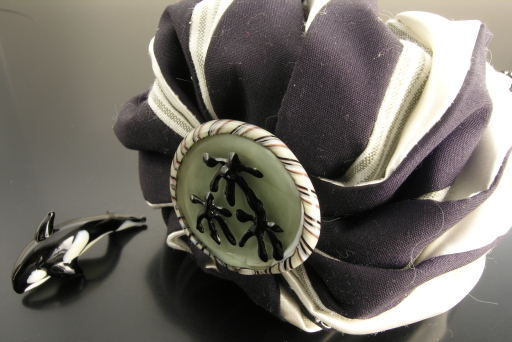This project was kind of interesting because it combines a number of different disciplines—lampworking, both off mandrel and on, braiding, and sewing.

drawstring bag, about 4" high. Assorted fabrics, silk cord, glass button, Jun 2008. Drawstring cord, disk braided, 16 strands, FFF silk, diamond patterned kongo.
I started with the figurine, which came out of a conversation I'd had earlier with the recipient: every so once in awhile I threaten to do a comic strip. The particular version I was interested in this time was to depict various friends and family members as animals, and the recipient picked an orca "because they're cute". I never got around to making the strip, but lacking any better idea, plus of course the fact that fish and dolphins are relatively easy to make, I went with this. It still took forever to get the tail done.
The braid was similarly rough: I made it using a foam disk, and even by my rather lax standards, it's pretty bad, with loops of loose threads throughout. Moreover, some of the silk snagged in the velcro of my purse and got rather ripped up. However, it's vastly more portable, not to mention that the slots store the ends firmly in place pretty much continuously, making the foam-disk considerably more practical than attempting to braid with a marudai in a car (yes I've attempted it, and the tama slide terribly all over the kagami when going around turns.)
Interestingly enough, JDftY was intrigued enough by this method to
ask me to teach it to her so she could make herself bracelets and
anklets, so I gave her a card and some yarn and string to make kumi
herself. My sense of humor being what it is, I couldn't help finding
a certain amount of irony in an American teaching a native Japanese a
Japanese art—using a typically dumbed-down
pragmatic American[1] approach besides.

Showing the interior (possibly of kimono scrap silk) and off-mandrel figurine, of black and ivory effetre. Jun 2008. Roughly 30–35 mm long.
So the last piece I made, after we returned from our trip, and for which I had three days to complete, was the drawstring bag, from which I'd gotten the pattern out a delightful book by Kumiko Sudo called Omiyage. Again, my seams weren't straight, my pieces weren't even—none of that Japanese precision—but on the other hand the quilted effect that came out of twisting the pleats gave padding to protect the figurine.
Why a figurine? Well, my beloved grade-school art teacher, Mrs. Smith, once gave me a little orange and red lampworked snake. It probably took all of two minutes to make, but I loved that thing because she gave it to me; though it's been lost for years. Then, when I attended Immaculata high school, I was, like all frosh, assigned a senior Big Sister. I've long since forgotten her name or what she looked like, but again, she gave me a beautiful little ceramic figurine of a horse. That I still have, but at least two of its legs are broken. —So I thought, I should give some co-ordinating protective storage my glass goodie, and it had the added benefit of incorporating textiles, as well as melding US and Japanese methods and styles.
Besides braiding my own cord, another modification on the original
design was to make a glass button, rather than a fabric covered one.
I screwed up the first one I made, putting on three of the kanji for
‘big’ (I couldn't remember whether the vertical stroke was supposed to
extend below the hoizontal crossbar) instead of ‘tree’: three tree
kanji mean ‘forest’; so does ‘sylvus’. Like everything else in this
project, they're rather very crudely executed, but hey, there you have it,
a small, light going away gift that wouldn't substantially add to her
luggage and that I hoped would serve as a pleasing memento of a school
year spent far from home.
file created 19apr08; minor grammatical edit, & correction as to origin of foam disk, 12sep15; 2008 year tag, 22aug23
[1]Actually, the disk was invented by Makiko Tada, but I didn't learn that till years later, as the various knockoffs of her product made no reference to the original inventor.
Unless otherwise noted, text, image and objects depicted therein copyright 1996--present sylvus tarn.
Sylvus Tarn